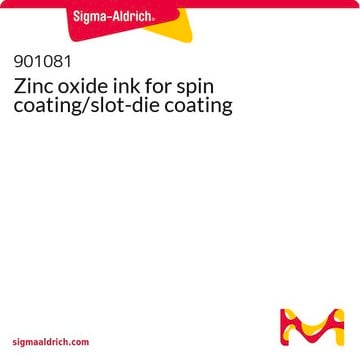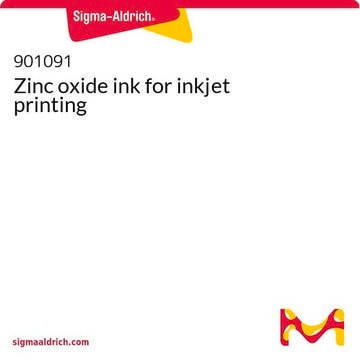808253
Zinc oxide nanoparticle ink
2.5 wt. %, viscosity 2.1 cP, work function -3.9eV
Synonym(s):
Avantama N-11, Nanograde N-11, ZnO ink, ZnO nanoparticle ink, zinc oxide dispersion, zinc oxide suspension
About This Item
Recommended Products
Quality Level
form
dispersion
concentration
2.5 wt. % (crystalline ZnO in isopropanol)
work function
-3.7--4.1 eV
color
translucent brownish
particle size
8-16 nm
viscosity
1.6-2.6 cP
Looking for similar products? Visit Product Comparison Guide
Related Categories
Application
Preparation Note
- Storage: In dark at room temperature.
- Prior to application: Shake, ultrasonicate with sonic horn and (optionally) filter through 0.45μm PTFE filter.
- Post-treatment: Annealing of deposited ZnO films at 80°C - 120°C.
Legal Information
Signal Word
Danger
Hazard Statements
Precautionary Statements
Hazard Classifications
Aquatic Chronic 2 - Eye Irrit. 2 - Flam. Liq. 2 - STOT SE 3
Target Organs
Central nervous system
Storage Class Code
3 - Flammable liquids
WGK
WGK 2
Flash Point(F)
57.2 °F
Flash Point(C)
14 °C
Certificates of Analysis (COA)
Search for Certificates of Analysis (COA) by entering the products Lot/Batch Number. Lot and Batch Numbers can be found on a product’s label following the words ‘Lot’ or ‘Batch’.
Already Own This Product?
Find documentation for the products that you have recently purchased in the Document Library.
Customers Also Viewed
Articles
Find advantages of inorganic interface layer inks for organic electronic & other applications.
Professors Tokito and Takeda share design principles and optimization protocols for organic electronic devices, focusing on flexibility and low cost.
Professors Tokito and Takeda share design principles and optimization protocols for organic electronic devices, focusing on flexibility and low cost.
Professors Tokito and Takeda share design principles and optimization protocols for organic electronic devices, focusing on flexibility and low cost.
Our team of scientists has experience in all areas of research including Life Science, Material Science, Chemical Synthesis, Chromatography, Analytical and many others.
Contact Technical Service







